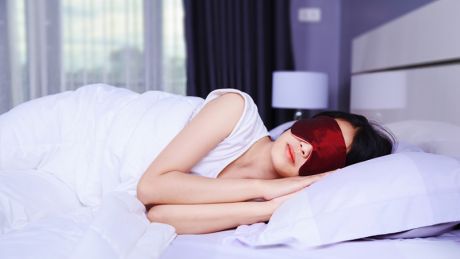Sleep Better Tonight With This Expert Advice
A good workout can promote a great night’s sleep as long as it’s done at the right time. We ask an expert when to get active

Just as sleep forms an integral part of a healthy lifestyle, a healthy lifestyle can promote better sleep. And exercise can make a big difference when it comes to drifting off. According to Professor Paul Gringras, a sleep medicine clinician, academic and scientific advisor to the makers of Leesa Sleep, “exercise can improve sleep quantity and quality and is one of the best ‘sleep medicines’ around”.
But the timing and intensity of a workout is crucial if you want to reap the restful rewards. We asked Professor Gringras for his advice on when and how to exercise for a better night’s sleep as well as his top tips to improve your snooze.
How And When To Exercise To Improve Your Sleep
Based on a lab study that showed an improvement in sleep quality for a group taking 30 minutes of vigorous exercise a day, Professor Gringras recommends aiming for something “that leaves you slightly out of breath”. Whether that’s a run around the park or a game of five-a-side depends on your personal fitness levels but it’s important to consider the timing if you’re looking to introduce a regime to help you sleep soundly. Exercising in the morning is unlikely to have an effect by the time you hit the sack, while squeezing in some activity too close to bedtime could keep you up for longer. For the best results, Professor Gringras recommends taking 20 to 30 minutes of moderate exercise between 4pm and 7pm.
The Benefits Of A Good Night’s Sleep
Good-quality sleep is essential for maintaining even the most basic cognitive skills like listening and communicating, and a lack of it can seriously affect both your physical health and mental wellbeing. Persistent poor sleep has been linked to an increased risk of diabetes, heart disease and obesity as well as conditions like depression and anxiety. And Professor Gringras reports that “improving sleep quality and quantity can improve sports performance and reduce risk of injury”, while even low levels of fatigue can impair reaction times.
Top Tips For Improving Sleep Quality
As well as introducing moderate exercise to your daily routine, there a few simple steps that you can take to improve your sleep quality.
1. Keep Cool
Aim to keep your bedroom temperature between 18.5 and 20°C so that your body doesn’t have to regulate its temperature by sweating or shivering. Invest in cotton bedding and pyjamas for when it’s warm because the material can help draw sweat away from the body.
2. Unplug The Earplugs
A bit of background noise can help you drift off by providing a gentle, calming hum to drown out intermittent noises that might otherwise wake you up. Try a talk radio show or a classical playlist; the more familiar and monotonous the better. Or use pink noise (a steady stream of high and low frequencies), which is said to be more effective at promoting sleep, and less irritating, than white noise.
3. Use Relaxation Techniques
Professor Gringras suggests trying a couple of proven relaxation techniques to help encourage sleep. Progressive muscle relaxation (tensing your muscles as tightly as possible and then completely relaxing them) can be really effective. So can mindfulness, which encourages you to focus on the “here and now” and the detailed nuances of breathing.
4. Toss The Tech
Exposure to blue light sources (TVs, smartphones, tablets) can negatively affect the brain’s ability to produce melatonin. If you’re able to, leave your electronics outside the bedroom or aim to switch them off at least an hour before bedtime. If you can’t ditch the devices, try wearing orange-tinted “blue blocker” glasses or downloading an app like Blue Light to alter the colours emitted by your screens.
5. Consider A New Mattress
An old mattress or the wrong kind of mattress can affect your sleep quality so it’s well worth trying out a new one if you’re uncomfortable or find it difficult to nod off. Luckily, there are plenty of companies that offer 100-night risk-free trials so you can test one out in the comfort of your own home before parting with your cash.
Featured Mattress: The Leesa Mattress
Made from three premium foam layers of differing density, the Leesa mattress features a 15cm base layer for support and durability, a 5cm middle layer of pressure-relieving memory foam, and a 5cm cooling top layer of Avena foam to provide bounce and movement. This unique combination is designed to adapt to your shape, providing optimal support and comfort for all body sizes and sleeping styles.
It’s made in the UK and is delivered to your door, compressed in an easy-to-manoeuvre box. Every purchase offers a 100-night, risk-free trial so you can try before you fully commit to buying, as well as a reassuring 10-year warranty.
The Leesa mattress currently has over 13,000 5-star reviews worldwide and has been awarded a string of accreditations, including a Which? Best Buy and a Good Housekeeping Institute approval.
Leesa operates a One-Ten social impact programme, which donates one mattress for every ten sold, supporting organisations serving homeless and at-risk men, women and children.
Find out more about the Leesa mattress and the Leesa One-Ten programme at www.leesa.co.uk
Start your 100-night risk-free trial with Leesa
Disclaimer: This advice reflects Professor Gringras’ opinions based on his understanding of the sleep medicine field at the moment. But please bear in mind that all medical research changes rapidly, and research can become out of date. Also whilst the information is as accurate as possible right now, it is only general advice and should not be used as a substitute for individual advice you might receive from medical professionals.
Get the Coach Newsletter
Sign up for workout ideas, training advice, reviews of the latest gear and more.
Coach is a health and fitness title. This byline is used for posting sponsored content, book extracts and the like. It is also used as a placeholder for articles published a long time ago when the original author is unclear. You can find out more about this publication and find the contact details of the editorial team on the About Us page.


